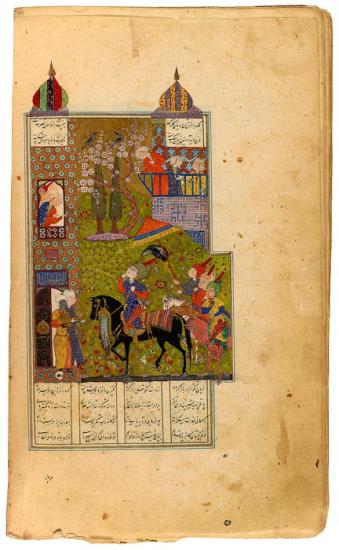
Shīrīn Lectures Khusrau
Khamsa (Quintet), in Persian, written by Mun˓im al-Din al-Auḥadī
Purchased by Pierpont Morgan, 1911
Deeply pained to learn that Khusrau was responsible for his rival Farhad's death as well as of the prince's affair with Shekar of Isfahan, Shīrīn will speak to him only from the roof when he comes to her palace to beg forgiveness. She reproaches him for causing her to suffer and for being merry from wine. If he is seeking love, he must be sober and marry her. They are then united in perfect love.
Many years later, Khusrau's son, lusting after his throne and wife, imprisoned him in a dungeon, where he was assassinated. After the splendid burial, Shīrīn, who had agreed to marry him, asked to be left alone for a final farewell, locked the vault door, and fatally stabbed herself.
This episode appears in Khusrau va Shīrīn (1180), the second story in Niẓāmī's Khamsa (Quintet).
Persian poetry
The Persians loved their poetry and their poets, though the Qur˒an warned against believing their words (sura 69.41) and "those straying in evil who follow them" (sura 26.224). While Arabic was the first language of Islam and the language of the Qur˒an, Persian was favored by poets. Even Firdausī's (940–1020) celebrated Shāhnāma (Book of Kings), the national epic of Persian, was written in verse—some 50,000 couplets! Rūmī (1207–1273), the best known of the Sufi poets, put poetry in perspective when he wrote, "A hundred thousand books of poetry existed / Before the word of the illiterate [Prophet] they were put to shame!" (Masnavī I, 529). Presented here are illustrations of Firdausī's Shāhnāma as well as works by Sa˓ dī (ca.1184–1292), Hāfiz (ca. 1320–1389), and Jāmī (1414–1492), regarded as the last of the great Sufi poets. Also featured are illustrations from each of the five poems of the Khamsa (Quintet), by Niẓāmī (ca. 1141–1209), especially Lailā and Majnūn (The Persian Romeo and Juliet) and Bahrām Gūr's Seven Princesses.
